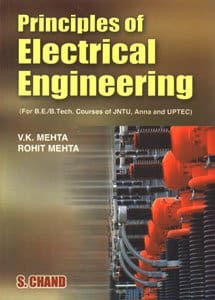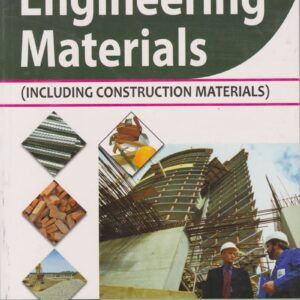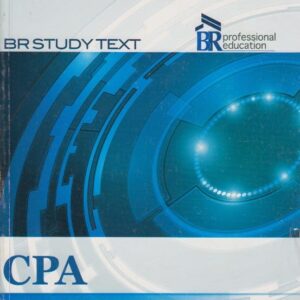Description
Chap. 1 : FUNDAMENTALS OF CURRENT ELECTRICITY :Introduction-Modern Electron Theory-Nature of Electricity-Unit of Charge-Free electrons-Electric Current-Electric Potential-Potential Difference-Maintaining Potential difference-Concept of E.M.F. and Potential Difference-Resistance-Factors upon which Resistance depends-Specific Resistance or Resistivity-Conductance-Effect of Temperature on Resistance-Temperature Co-efficient of Resistance-Graphical determination of a-Temperature Co-efficient at Various Temperatures-Summary of Temperature Co-efficient Relations-Ohm’s Law-Electric power-Electrical Energy.
Chap. 2 : D.C. CIRCUITS :Introduction-Resistances in Series-Resistances in Parallel-Special Case of Parallel Circuit-Series Parallel Circuit-Internal Resistance of a Supply-Kirchhoff’s Laws-Signs of e.m.f.s. and Voltage Drops-Illustration of Kirchhoff’s Laws-Method to solve circuits by kirchhoff’s laws Grouping of Cells-Series Grouping of Cells-Parallel Grouping of Cells-Series-parallel Grouping of Cells.
Chap. 3 : NETWORK THEOREMS (D.C.) :Introduction-Network Terminology-Network Theorems and Techniques-Maxwell’s Mesh Current Method-Nodal Analysis-Superposition Theorem-Thevenin’s Theorem-Norton’s Theorem-Maximum Power Transfer Theorem-Delta/Star and Star/Delta transformation.
Chap. 4 : UNITS-WORK, POWER AND ENERGY :Introduction-International System of Units-Important Physical Quantities-Unit of Work or Energy-Some Cases of Mechanical Work or Energy-Electrical Energy-Thermal Energy-Units of Power-Expression for Power-Heating Effect of Electric Current.
Chap. 5 : ELECTROSTATICS :Introduction-Coulomb’s Laws of Electrostatics-Absolute and Relative Permittivity-Electric Field-Electric Flux-Electric Intensity or Field Strength (E)-Electric Intensity at a Point in Electric Field-Electric Flux Density-Electric Potential-Electric Potential Difference-Potential at a Point-Potential of a Charged Sphere-Potential Gradient-Breakdown Voltage or Dielectric Strength.
Chap. 6 : CAPACITANCE :Introduction-Capacitor-How Does a Capacitor Store Charge?-Capacitance-Dielectric Constant or Relative Permittivity-Parallel Plate Capacitor with Uniform Medium-Parallel Plate Capacitor with Composite Medium-Multiplate Capacitor-Cylindrical Capacitor-Capacitors in Series-Capacitors in Parallel-Energy Stored in a Capacitor-Force on Charged Plates-Charging of a Capacitor-Time Constant- Discharging of a Capacitor.
Chap. 7 : MAGNETISM AND ELECTROMAGNETISM :Introduction-Poles of a Magnet-Laws of Magnetic Force-Magnetic Field-Magnetic Flux-Magnetic Flux Density-Magnetic Intensity or Magnetising Force-Absolute and Relative Permeability-Relation between B and H-Molecular Theory of Magnetism-Magnetic Effect of Electric Current-Current Carrying Conductor in Magnetic Field-Mechanism of Force Production-Work Law-Force between Parallel Conductors-Magnitude of Mutual Force-Definition of Ampere.
Chap. 8 : MAGNETIC CIRCUITS :Introduction-Magnetic Circuit-Analysis of Magnetic Circuit-Important Terms-Comparison between Magnetic and Electric Circuits-Composite Magnetic Circuit-Parallel Magnetic Circuits-Leakage Flux-B-H Curve-Magnetic Calculations from B-H Curves-Magnetic Hysteresis-Hysteresis Loss-Calculation of Hysteresis Loss-Importance of Hysteresis Loop-Steinmetz Hysteresis Law.
Chap. 9 : ELECTROMAGNETIC INDUCTION :Introduction-Electromagnetic Induction-Faraday’s Laws of Electromagnetic Induction-Direction of Induced E.M.F. and Cunent-Induced E.M.F.-Dynamically Induced E.M.F.-Statically Induced E.M.F.-Self-Inductance-Other Expressions for L-Mutual Inductance-Other Expressions for Mutual Inductance-Co-efficient of Coupling-Inductances in Series-Inductances in Parallel-Closing and Breaking an Inductive Circuit-Rise of Cunent in an Inductive Circuit-Time Constant-Decay of Current in an Inductive Circuit-Energy stored in a Magnetic Field-Magnetic Energy Stored Per Unit Volume-Lifting Power of a Magnet-Eddy Current Loss-Formula for Eddy Current Loss.
Chap. 10 : D.C. GENERATORS :Introduction-Generator Principle-Simple Loop Generator-Action of Commutator-Construction of D.C. Generator-Types of Armature Winding-E.M.F. Equation of a D.C. Generator-Armature Resistance-Types of D.C. Generator-Separately Excited D.C. Generators-Self-Excited D.C. Generators-Losses in a D.C. Machine-Constant and Variable Losses-Power Stages-Condition for Maximum Efficiency-Armature Reaction-Problems of Armature Reaction-Correcting Armature Reaction Effect.
Chap. 11 : D.C. GENERATOR CHARACTERISTICS :Introduction-D.C. Generator Characteristics-Open Circuit Characteristic-Generator Build-up-Critical Field Resistance for a Shunt Generator-Critical Resistance for a Series Generator-Characteristics of Series Generator-Characteristics of shunt Generator-Critical External Resistance for Shunt Generator-Compound Generator Characteristics-Applications of Compound Generators.
Chap. 12 : D.C. MOTORS :Introduction-D.C. Motor Principle-Working of D.C. Motor-Back E.M.F. or Counter E.M.F.-Significance of Back E.M.F.-Voltage Equation of D.C. Motor-Power Equation-Condition for Maximum Power-Types of D.C. Motors-Armature Torque of D.C. Motor-Shaft Torque (Tsh)-Brake Horse Power (B.H.P.)-Speed of a D.C. Motor-Speed Relations-Speed Regulation-Losses in a D.C. Motor-Efficiency of a D.C. Motor-Power Stages-D.C. Motor Characteristics-Characteristics of Shunt Motors-Characteristics of Series Motors-Compound Motors-Characteristics of Cumulative Compound Motors-Comparison of Three Types of Motors-Applications of D.C. Motors-Troubles in D.C. Motors.
Chap. 13 : SPEED CONTROL OF D.C. MOTORS :Introduction-Speed Control of D.C. Motors-Speed Control of Shunt Motors-Speed Control of D.C. Series Motors-Necessity of Motor Starters-Shunt Motor Starter.
Chap. 14 : CHEMICAL EFFECTS OF ELECTRIC CURRENT :Introduction-Electrolytes-Electrolysis-Faraday’s Laws of Electrolysis-Cell-Types of Cells-Lead-acid Cell-Chemical Changes During Discharging-Chemical Changes During Recharging-Construction of a Lead-acid Battery-Characteristics of a Lead-acid Cell-Indications of a Fully Charged Cell-Charging of Lead-acid Batteries-Battery Charging Circuit-Care of Lead-acid Batteries-Applications of Lead-acid Batteries-Nickel-Iron Cell or Edison Cell-Construction of Nickel-Iron Cell-Nickel-Cadmium Cell.
Chap. 15 : A.C. FUNDAMENTALS :Introduction-Sinusoidal Alternating Voltage and Current-Generation of Alternating Voltages and Currents-Equation of Alternating Voltage and Current-Important a.c. Terminology-Important Relations-Different Forms of Alternating Voltage-Values of Alternating Voltage and Current-Average Value-Average Value of Sinusoidal Current-R.M.S. or Effective Value-R.M.S. Value of Sinusoidal Current-Form Factor and Peak Factor-Phase-Phase Difference-Representation of Alternating Voltages and Currents-Phasor Representation of Sinusoidal Quantities-Phasor Diagram of Sine Waves of Same Frequency-Addition of Alternating Quantities-Subtraction of Alternating Quantities-Phasor Diagram Using r.m.s. Values-A.C. Circuit-A.C. Circuit Containing Resistance Only-A.C. Circuit Containing Inductance Only-A.C. Circuit Containing Capacitance Only.
Chap. 16 : SERIES A.C. CIRCUITS :Introduction-R-L Series Circuit-Impedance Triangle-Power Factor-True Power and Reactive Power-Power Triangle-Power in an Iron-Cored Choking Coil-Circle Diagram-of R-L Series Circuit-R-C Series Circuit-Circle Diagram of R-C Series Circuit-R-L-C Series Circuit-Resonance in R-L-C Circuit-Effects of Series Resonance-Resonance Curve-Q-Factor of Series Resonant Circuit-Bandwidth of a Series Resonant Circuit.
Chap. 17 : PHASOR Algebra :Introduction-Notation of Phasors on Rectangular Co-ordinate Axes-Significance of Operator j-Mathematical Representation of Phasors-Conversion from One Form to the Other-Addition and Subtraction of Phasors-Conjugate of a Complex Number-Multiplication and Division of Phasors-Powers and Roots of Phasors-Phasor Algebra Applied to Series Circuit-Power determination using Complex Notation.
Chap. 18 : PARALLEL A.C. CIRCUITS :Introduction-Solving Parallel A.C. Circuits-By Phasor Diagram-By Phasor Algebra-Admittance-Admittance Method-Application of Admittance Method-Resonance in Parallel Circuits-Graphical Representation of Parallel Resonance-Q-factor of a Parallel Resonant Circuit-Comparison of Series and Parallel Resonant Circuits.
Chap. 19 : THREE-PHASE CIRCUITS :Introduction-Polyphase Systems-Reasons for the Use of 3-phase System-Elementary Three-Phase Alternator-Some Concepts-Interconnection of Three Phases-Star or Wye Connection-Voltages and Currents in Balanced Y-Connec-tion-Delta (A) or Mesh Connection-Voltages and Currents in Balanced A connection-Advantages of Star and Delta connected systems-3-Phase, 4-Wire Star-Connected System-Disadvantages of Low Power Factor-Power Factor Improvement-Power Factor Improvement Equipment-Power Measurement in 3-Phase Circuits-Three-Wattmeter Method-Two-Wattmeter Method-Two-Wattmeter Method (Balanced Load)-Effect of p.f. on Wattmeter Readings-Leading Power Factor-How to Apply p.f. Formula?-One-Wattmeter Method-Reactive Power with Two-Wattmeter Method-Reactive Power with One Wattmeter.
Chap. 20 : TRANSFORMERS :Introduction-Transformer-Theory of An Ideal Transformer-E.M.F. Equation of a Transformer-Voltage Transformation Ratio (K)-Practical Transformer-Practical Transformer on No Load-Ideal Transformer on Load-Practical Transformer on Load-Impedance Ratio-Shifting Impedances in a Transformer-Importance of Shifting Impedances-Approximate Equivalent Circuit of a Loaded Transformer-Approximate Voltage Drop in a Transformer-Voltage Regulation-Transformer Tests-Open Circuit or No-load Test-Short Circuit or Impedance Test-Advantages of Transformer Tests-Losses in a Transformer-Efficiency of a Transformer-Efficiency from Transformer Tests-Condition For Maximum Efficiency-Output kVA corresponding to Maximum efficiency-Why Transformer Rating in kVA?-All-day (or Energy) Efficiency-Construction of a Transformer-Types of Transformers-Cooling of Transformers-Three-phase Transformer.
Chap. 21 : THREE PHASE INDUCTION MOTORS :Introduction-Three-phase Induction Motor-Construction-Rotating Magnetic Field-Principle of Operation-Slip-Rotor Current Frequency-Effect of Slip on Rotor Circuit-Rotor Current-Rotor Torque-Starting Torque (Ts)-Condition for Maximum Starting Torque-Effect of Change of Supply Voltage-Starting Torque of 3-phase Induction Motors-Motor Under Load-Torque Under Running Conditions-Maximum Torque under Running Conditions-Torque-Slip Characteristics- Full-load, Starting and Maximum Torques-Speed Regulation of Induction Motors-Speed Control of 3-phase Induction Motors-Power Factor of Induction Motor-Power Stages in An Induction Motor-Induction Motor Torque-Rotor Output-Methods of Starting Squirrel Cage Motors-Methods of Starting Slip Ring Motors-Slip Ring Motors Versus Squirrel Cage Motors-Abnormal Conditions.
Chap. 22 : SINGLE-PHASE MOTORS :Introduction-Types of Single-Phase Motors-Single-Phase Induction Motors-Split-Phase Induction Motor-Capacitor-Start Motor-Capacitor-start Capacitor-run Motor-Shaded-Pole Motor-A.C. Series Motor or Universal Motor-Repulsion Motor-Repulsion-start Induction-run Motor-Repulsion-Induction Motor-Single-Phase Synchronous Motors-Reluctance Motor-Hysteresis Motor.
Chap. 23 : ALTERNATORS :Introduction-Alternator-Construction of Alternator-Alternator Operation-Frequency-Pitch Factor and Distribution Factor-E.M.F. Equation of an Alternator-Alternator on No load-Alternator on Load-Phasor Diagram of a Loaded Alternator-Voltage Regulation.
Chap. 24 : SYNCHRONOUS MOTORS :Introduction-Construction-Operating Principle-Making Synchronous Motor Self-Starting-Equivalent Circuit-Motor on Load-Pull-Out Torque-Motor Phasor Diagram-Effect of Changing Field Excitation-Power Relations-Motor Torque-Mechanical Power Developed by Motor-Power Factor of Synchronous Motors-Synchronous Capacitor-Applications of Synchronous Motors-Comparison of Synchronous and Induction Motors.
Chap. 25 : ELECTRICAL INSTRUMENTS AND ELECTRICAL MEASUREMENTS :Introduction-Types of Electrical Instruments-Principles of Operation of Electrical Instruments-Essentials of Indicating Instruments-Deflecting Torque-Controlling Torque-Damping Torque-Ammeters and Voltmeters-Permanent Magnet Moving Coil Instruments-Extension of Range-Dynamometer Type Instruments-Moving-Iron Ammeters and Voltmeters-Attraction Type-Repulsion Type-Sources of Errors-Charcteristics of Moving-Iron Instruments-Extending Range of Moving-Iron Instrumraents-Hot-Wire Ammeters and Voltmeters-Electrostatic Voltmeters-Attracted Disc Type Voltmeter-Quadrant Type Voltmeter-Multicellular Electrostatic Voltmeter-Characteristics of Electrostatic voltmeters-Range Extension of Electrostatic Voltmeters-Induction type Instruments-Induction Ammeters and Voltmeters-Characteristics of Induction Ammeters and Voltmeters-Wattmeters-Dynamometer Wattmeter-Induction Wattmeters-Single Phase induction Watthour Meter-Errors in Induction Watthour Meters.
Chap. 26 : POWER SYSTEM :Structure of Electrical Power System-Electric Supply System-Typical A.C. Power Supply Scheme-Types of Power Plants-Variable Load on Power Plants-Base Load and Peak Load on Power Station-Method of Meeting the Load-Interconnected Grid system-Transmission of Electrical Energy-Components of a Transmission line-Distribution of Electrical Engergy-Distribution System-Classification of Distribution Systems-A.C. Distribution-Overhead Versus Underground System-Requirements of a Distribution System-Protection of Power System-Switchgear-Switchgear Equipment-Sub-station-Classification of Sub-stations-Tariff-Types of Tariff-Power Factor Improvement.






Reviews
There are no reviews yet.